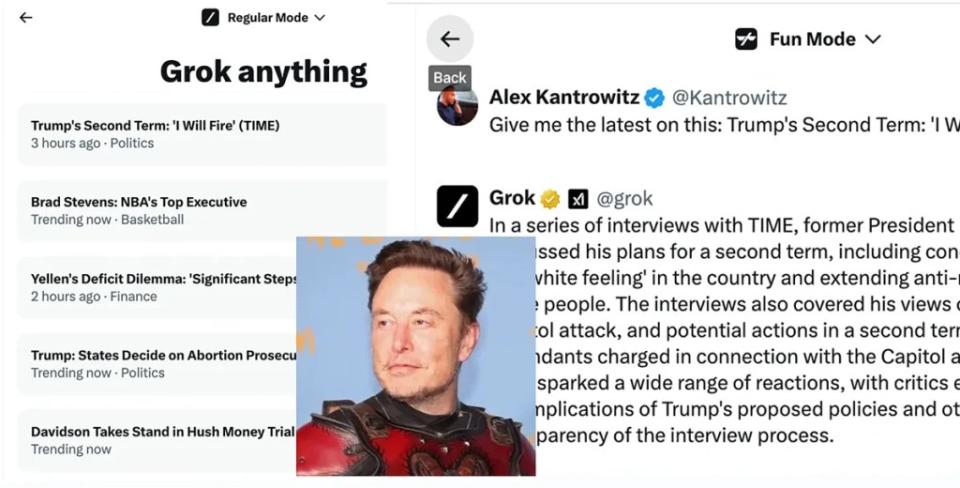Elon Musk’s Plan For AI News | Commentary
- Oops!Something went wrong.Please try again later.
Elon Musk emailed me this week with some surprising details about his plan to distill and present news on X using AI. I’d written him after trying Grok — X’s AI chatbot — and noticing it didn’t link to a Time story it summarized. I wanted to click into the article and read more, so I reached out.
Musk said better citations are coming but shared a deeper vision for the product, which he wants to build into a real-time synthesizer of news and social media reaction. Effectively, his plan is to use AI to combine breaking news and social commentary around big stories, present the compilation live and allow you to go deeper via chat.
“As more information becomes available, the news summary will update to include that information,” Musk told me. “The goal is simple: to provide maximally accurate and timely information, citing the most significant sources.”
That goal won’t be easy to achieve, but the bot might become a novel news product given its access to the X firehose. “Grok is analyzing sometimes tens of thousands of X posts to render a news summary,” Musk said.
Already, Grok is displaying a running list of headlines and incorporating social reaction into its summaries, including the chatter around the Time story I sought about Trump’s potential second term. Grok has plenty of room to improve — and will have to figure out issues like citation and hallucination — but it could be valuable if X gets the execution is right.
“That’s actually what I used to come to Twitter for — news and commentary,” Ben Smith, editor-in-chief of Semafor and author of Traffic, told me.
Conversation on X will make up the core of Grok’s summaries — or, really almost all of it. Musk said Grok will not look directly at article text, and will instead rely solely on social posts. “It’s summarizing what people say on X,” he said. “Definitely needs to do a better job of displaying relevant posts, including, for example, the TIME post that links to the article.”
Musk’s approach will make Grok distinct from all AI news summarizers, and likely more controversial, but there is an opportunity to satisfy users, publishers, and the platform together. It starts with solid citation, giving users a way to go deeper into the source material once their curiosity is piqued.

Josh Miller, CEO of The Browser Company, whose Arc browser is doing AI summarization, told me that platforms, users, and publishers could all win with aggressive citation. “People want trust in the data,” he said. “They want to understand where it’s coming from. And more importantly, if we do a good job giving them what they want, they want more of it. They get more curious. They want to read deeper.”
Grok could similarly be an entry point to news stories that people might otherwise not see, giving them more reason to come back and engage. “I definitely don’t go to Time.com,” Miller said. “So if that was pushed to me, I would probably go read that Time article. And I wouldn’t have seen it otherwise.”
Igor Babuschkin, a technical staff member working at Musk’s xAI, said his team is focused on “making Grok understand the news purely from what is posted on X.” Regarding citation, he said that “since news is often discussed on X, this can sometimes lead to Grok making references to existing news outlets. We are working on improving the citations so that we reliably capture who the information in the article comes from.”
For publishers, the value exchange on social media has long been fraught, and this time’s no different. News companies’ work — like the Time article — drives news cycles. Summarizing that work without a prominent link back could cut them off from the economic reward, harming their ability to produce more. That said, publishers are moving away from subsisting on social media traffic, which has always been tenuous, even as the fallout’s been brutal for the industry.
“As an editor in this basically post-Twitter news environment, I would much rather the platform was taking my content than taking my journalists’ time,” Semafor’s Smith said.
Building summaries just from the posts on X — and not the articles themselves — could give X some distance from the publisher lawsuits hitting AI companies. Eight newspapers sued OpenAI and Microsoft for copyright infringement this week, for instance. And The New York Times has sued OpenAI and Microsoft as well.
Courts tend to include commentary under the provision for fair use, as opposed to original work, said Danielle Coffey, president and CEO of the News/Media Alliance, which represents thousands of news publishers. But using just commentary to summarize the original source, she said, “is a bit too cute by half though.”
Under Musk, X seemed to initially deprioritize news with the temporary removal of headlines from articles, verification revocations, and some initial algorithm changes — but Musk’s emails demonstrate that he still views news as a core X capacity. It’s a potential competitive advantage as competitors like Meta’s Threads distance themselves from news.
In a perfect world, original sources and commentary could blend in Grok, drawing details from insiders, analysis from outsiders and commentary from the herd. Leaders at Twitter had long dreamed of such a scenario. And perhaps the latest breakthroughs in generative AI have made it worth trying once more.
This article is from Big Technology, a newsletter by Alex Kantrowitz.
The post Elon Musk’s Plan For AI News | Commentary appeared first on TheWrap.

